Battle
On 23 May, Garibaldi took Varese. Gyulai then sent Karl von Urban's force of 4,000 northward. [7] However, the Austrian Feldmarschall-leutnant only had at his disposal approximately 2.000 infantry at the time of the engagement. [8]
On the 26 May, at dawn, Urban arrived at Varese, where Garibaldi already had placed two robust defensive lines. The Italians were deployed as: one battalion (Enrico Cosenz) on the right, two battalions on the left (Giacomo Medici), one battalion in the middle (Nicola Ardoino); two reserve battalions, one at Varese (Nino Bixio), and one at the Biumo Superiore hill.
The Austrians opened fire with the guns, then moved three columns against the enemy. Cosenz's battalion attacked the incoming Austrians, and routed them into the other columns, repulsing the Austrian attack with the help of the Medici battalion. Urban, evaluating correctly that the enemy forces were more numerous and well entrenched, ordered a retreated on Binago and San Salvatore [ it ]. At San Salvatore the Austrians resisted the advance of Medici and Ardoino, who were charged by Garibaldi to attack the retreating Austrians. The encounter that followed was a victory to Urban, who, after repulsing the Cacciatori delle Alpi, proceeded to reentry Como in good order.

The Battle of Solferino on 24 June 1859 resulted in the victory of the allied French army under Napoleon III and the Piedmont-Sardinian army under Victor Emmanuel II against the Austrian army under Emperor Franz Joseph I. It was the last major battle in world history where all the armies were under the personal command of their monarchs. Perhaps 300,000 soldiers fought in the important battle, the largest since the Battle of Leipzig in 1813. There were about 130,000 Austrian troops and a combined total of 140,000 French and allied Piedmontese troops. After the battle, the Austrian emperor refrained from further direct command of the army.

Urbano Pio Francesco Rattazzi was an Italian politician and statesman.

The Kingdom of Lombardy–Venetia, commonly called the "Lombardo-Venetian Kingdom", was a constituent land of the Austrian Empire from 1815 to 1866. It was created in 1815 by resolution of the Congress of Vienna in recognition of the Austrian House of Habsburg-Lorraine's rights to the former Duchy of Milan and the former Republic of Venice after the Napoleonic Kingdom of Italy, proclaimed in 1805, had collapsed.

The Kingdom of Italy was a kingdom in Northern Italy in personal union with Napoleon I's French Empire. It was fully influenced by revolutionary France and ended with Napoleon's defeat and fall. Its government was assumed by Napoleon as King of Italy and the viceroyalty delegated to his stepson Eugène de Beauharnais. It covered some of Piedmont and the modern regions of Lombardy, Veneto, Emilia-Romagna, Friuli-Venezia Giulia, Trentino, South Tyrol, and Marche. Napoleon I also ruled the rest of northern and central Italy in the form of Nice, Aosta, Piedmont, Liguria, Tuscany, Umbria, and Lazio, but directly as part of the French Empire, rather than as part of a vassal state.
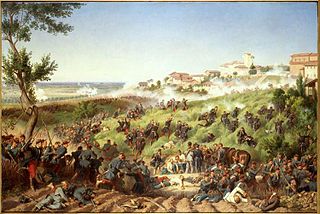
The Battle of Montebello was fought on 20 May 1859 at Montebello. It was the first major engagement of the Second Italian War of Independence, fought between Austrian troops commanded by Field Marshal Karl von Urban against Piedmontese cavalry and French infantry headed by General Elie Foray.

The Golasecca culture was a Late Bronze Age/Early Iron Age culture in northern Italy, whose type-site was excavated at Golasecca in the province of Varese, Lombardy, where, in the area of Monsorino at the beginning of the 19th century, Abbot Giovanni Battista Giani made the first findings of about fifty graves with pottery and metal objects.

The Ten Days of Brescia was a revolt which broke out in the northern Italian city of that name, which lasted from 23 March to 1 April 1849.

The Skirmish of Pastrengo was fought between the Piedmontese and Austrian army on 30 April 1848, in the course of the First Italian War of Independence.
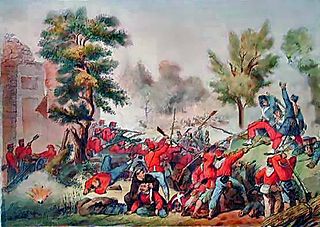
The Battle of the Volturno refers to a series of military clashes between Giuseppe Garibaldi's volunteers and the troops of the Kingdom of Two Sicilies occurring around the River Volturno, between the cities of Capua and Caserta in northern Campania, in September and October 1860. The main battle took place on 1 October 1860 between 30,000 Garibaldines and 25,000 Bourbon troops (Neapolitans).

The Battle of Crevola was fought in the spring of 1487, between a marauding Swiss army from the Valais and Lucerne and troops from the Duchy of Milan, for the supremacy of the Val d'Ossola (Eschental).

The Five Days of Milan was an insurrection and a major event in the Revolutionary Year of 1848 that started the First Italian War of Independence. On 18 March, a rebellion arose in the city of Milan which in five days of street fighting drove Marshal Radetzky and his Austrian soldiers from the city.
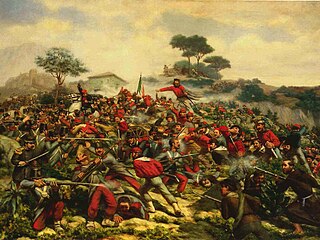
The Battle of Calatafimi was fought on the 15 May 1860 between Giuseppe Garibaldi's Redshirts and the troops of the Kingdom of the Two Sicilies at Calatafimi, Sicily, as part of the Expedition of the Thousand. The battle was the first of Garibaldi's victory during his invasion of Sicily in 1860 and saw his 'Thousand' defeat a larger Neapolitan army sent from Palermo to block the roads to the Sicilian capital.

Karl (Carl) Freiherr von Urban was an Austrian Field Marshal-Lieutenant celebrated for his daring tactics of lightning surprise attacks, often against much stronger forces, which earned him the epithet of Austrian Garibaldi.
The Battle of Motta was fought in late August 1412, when an invading army of Hungarians, Germans and Croats, led by Pippo Spano and Voivode Miklós Marczali attacked the Venetian positions at Motta in Italy and suffered a heavy defeat.

The sortie on Mestre occurred during the revolutionary year of 1848 on October 27.
Italian volunteers charged the Austrian fortification, took the town and withdrew, with the loot of three baggage-waggons, eight horses, large quantity of ammunition and the military chest, back to the fort at Marghera.

The Battle of San Fermo, which took place the 27 May 1859 at a pass near Como in the northern part of Lombardy, was an engagement of the Second Italian War of Independence in which the Italian volunteers of Giuseppe Garibaldi's Hunters of the Alps defeated an Austrian force, forcing the Austrians to abandon Como.
The following is a timeline of the history of the city of Parma in the Emilia-Romagna region of Italy.
Luigi Toro was an Italian painter and patriot. He painted historical canvases in a Romantic style.
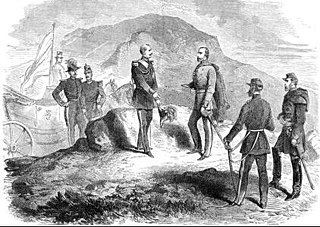
Ferdinando Lanza was a Two Sicilian lieutenant-general who fought against Garibaldi's Expedition of the Thousand. During the conflict, Lanza was stationed at Palermo but surrendered after the siege on May 30, 1860.
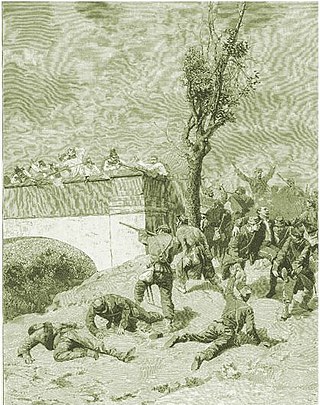
The Battle of Treponti, also known as Battle of Castenedolo, took place on 15 June 1859, during the Second Italian War of Independence. The encounter opposed the Austrians led by Field Marshal Karl von Urban and the Sardinians commanded by Giuseppe Garibaldi. Von Urban employed a cunning stratagem that led to his victory over Garibaldi.

















